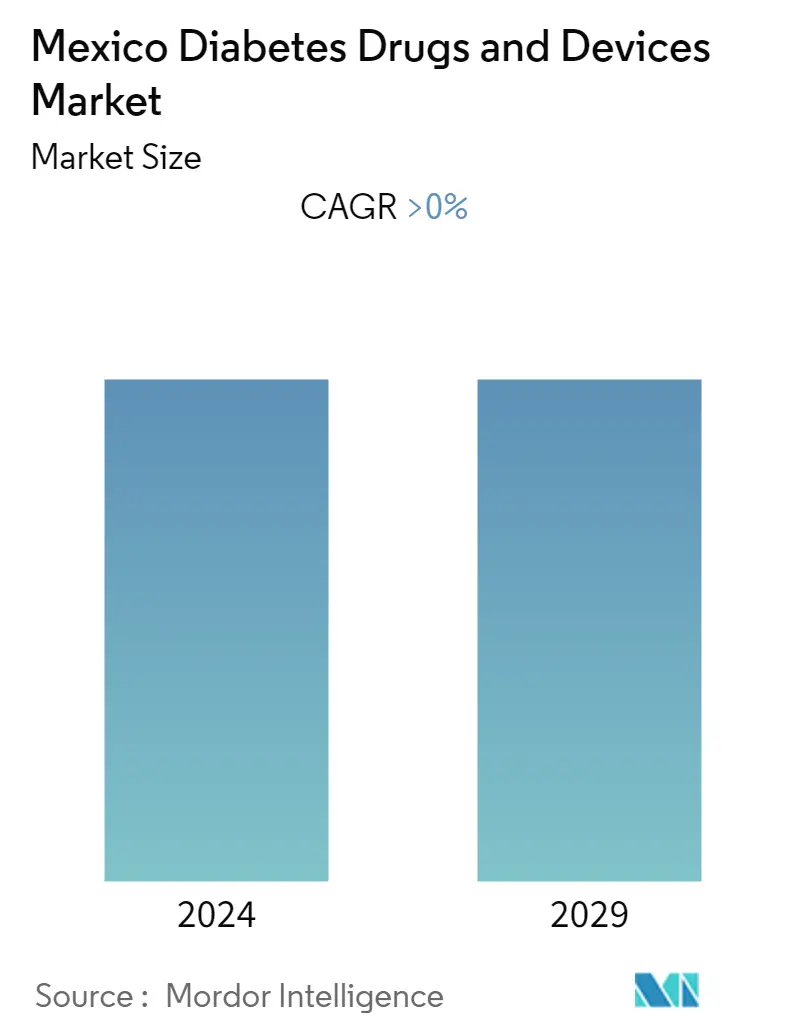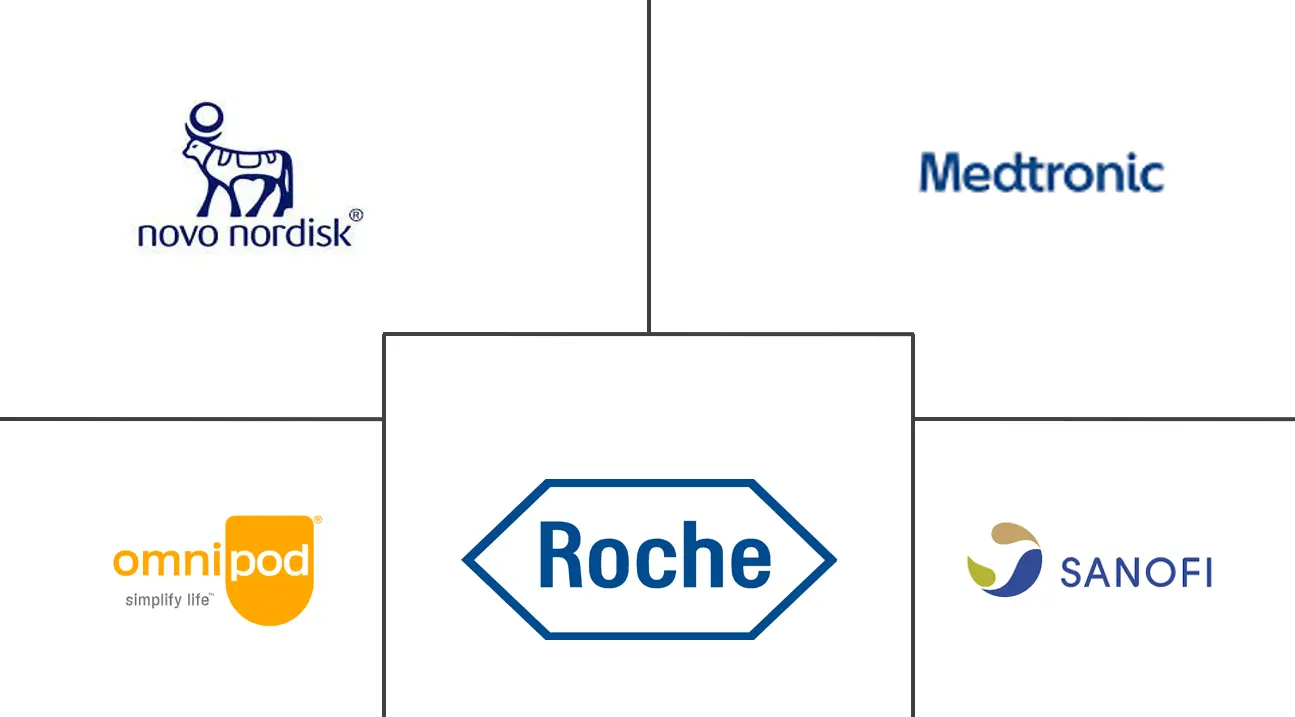Market Size of Mexico Diabetes Drugs and Devices Industry

| Study Period | 2018 - 2029 |
| Base Year For Estimation | 2023 |
| Forecast Data Period | 2024 - 2029 |
| Historical Data Period | 2018 - 2022 |
| CAGR | 0.00 % |
Major Players
*Disclaimer: Major Players sorted in no particular order |
Mexico Diabetes Drugs and Devices Market Analysis
Mexico's diabetes drugs and devices market size is estimated at USD 2.4 billion in the current year. The market is expected to reach USD 2.9 billion in five years, resitering a CAGR of more than 3.8% during the forecast period.
The COVID-19 pandemic has significantly impacted the diabetes care device market. Diabetes is a chronic disease that requires self-management and care. This includes regular attention to diet, physical activity, blood sugar monitoring, and taking medications. People with chronic diseases such as diabetes and obesity have a poor prognosis for COVID-19. A person with diabetes is twice as likely to develop comorbidities and die. Prepare your healthcare system for more severe cases of COVID-19, as studies suggest that poor glycemic control increases the risk of adverse outcomes in people with diabetes with SARS-CoV-2 infection. It needs to be better organized. Due to the prevalence of diabetes in patients hospitalized with COVID-19 and the recognition that improved glycemic control may improve outcomes and reduce the length of stay in patients with COVID-19 diabetes treatment, The importance of equipment is emphasized.
Diabetes prevalence in Mexico is currently 16.9%, or 1 in 6 adults, according to the IDF Diabetes Atlas 2021. This is a 10% increase over the last two years. Additionally, 11 million adults in the country have impaired glucose tolerance (IGT), putting them at high risk of developing type 2 diabetes. Diabetes-related healthcare spending in Mexico reached US$20 billion, making it one of the top 10 countries or regions with the highest overall healthcare spending. Less than half (47.5%) of people living with diabetes in this country are undiagnosed.
Suppose diabetes is not diagnosed or properly treated. In that case, people with diabetes risk serious and life-threatening complications such as heart attack, stroke, kidney failure, blindness and lower limb amputation. This leads to a lower quality of life and higher healthcare costs, increasing the need for access to healthcare. In Mexico, diabetes, especially type 2 diabetes, is the leading cause of death among women and the second leading cause of death among men, thus burdening healthcare. Factors that contribute to the development of diabetes include obesity, lack of exercise, poor eating habits, genetics, family background, and age.
Thus, the above factors are expected to drive market growth over the forecast period.
Mexico Diabetes Drugs and Devices Industry Segmentation
Patients with type 1 diabetes must be given insulin because their pancreas cannot process it. to control blood sugar levels, insulin must be given several times a day, such as when eating or drinking. many people with type 2 diabetes also need to take antidiabetic drugs. these drugs include diabetes medications and injections such as insulin. Mexico's diabetes drugs and devices market is segmented by drugs (insulin, oral anti-diabetic drugs, non-insulin injectable drugs, and combination drugs), and devices ( management devices (insulin pumps, insulin pens, syringes, cartridges, and jet injectors) and monitoring devices (self-monitoring blood and continuous glucose monitoring)). the report offers the value (in USD) and volume (in unit) for the above segments.
| Devices | ||||||
| ||||||
|
| Drugs | |
| Oral Anti-Diabetes Drugs | |
| Insulin Drugs | |
| Combination Drugs | |
| Non-Insulin Injectable Drugs |
Mexico Diabetes Drugs and Devices Market Size Summary
The diabetes drugs and devices market in Mexico is poised for significant growth, driven by the increasing prevalence of diabetes and the rising demand for effective management solutions. The market is characterized by a robust pipeline of innovative technologies and therapies aimed at improving patient outcomes. Continuous blood glucose monitoring devices, which offer advanced features such as real-time data sharing and integration with digital platforms, are gaining traction. These devices are becoming more affordable due to technological advancements, which is expected to further stimulate market expansion. The pharmaceutical industry is also playing a crucial role by integrating digital health solutions with traditional treatments, enhancing patient engagement and adherence to therapy regimens.
The healthcare landscape in Mexico is evolving to address the challenges posed by diabetes, a leading cause of morbidity and mortality in the country. The government's initiatives to provide health insurance coverage and reduce out-of-pocket expenses are pivotal in ensuring access to diabetes care for low-income populations. Collaborations between public and private sectors are facilitating the availability of diabetes devices at competitive prices. Additionally, the market is witnessing increased investment in research and development by key players, aiming to introduce novel drugs and devices. These efforts are supported by international collaborations and public awareness campaigns, which are expected to drive the market's growth trajectory over the forecast period.
Mexico Diabetes Drugs and Devices Market Size - Table of Contents
-
1. MARKET DYNAMICS
-
1.1 Market Overview
-
1.2 Market Dynamics
-
1.2.1 Market Drivers
-
1.2.2 Market Restraints
-
-
1.3 Porter's Five Forces Analysis
-
1.3.1 Bargaining Power of Suppliers
-
1.3.2 Bargaining Power of Consumers
-
1.3.3 Threat of New Entrants
-
1.3.4 Threat of Substitute Products and Services
-
1.3.5 Intensity of Competitive Rivalry
-
-
-
2. Market Segmentation (Market Size by Value - USD)
-
2.1 Devices
-
2.1.1 Monitoring Devices
-
2.1.1.1 Self-monitoring Blood Glucose Devices
-
2.1.1.2 Continuous Blood Glucose Monitoring
-
-
2.1.2 Management Devices
-
2.1.2.1 Insulin Pump
-
2.1.2.2 Insulin Syringes
-
2.1.2.3 Insulin Cartridges
-
2.1.2.4 Disposable Pens
-
-
-
2.2 Drugs
-
2.2.1 Oral Anti-Diabetes Drugs
-
2.2.2 Insulin Drugs
-
2.2.3 Combination Drugs
-
2.2.4 Non-Insulin Injectable Drugs
-
-
Mexico Diabetes Drugs and Devices Market Size FAQs
What is the current Mexico Diabetes Drugs and Devices Market size?
The Mexico Diabetes Drugs and Devices Market is projected to register a CAGR of greater than 0% during the forecast period (2024-2029)
Who are the key players in Mexico Diabetes Drugs and Devices Market?
Medtronics , Roche, Sanofi, NovoNordisk and Omnipod are the major companies operating in the Mexico Diabetes Drugs and Devices Market.

